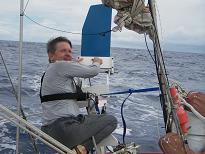 Picture is of George doing a great job of fixing the windvane today. It got overloaded today during a sail change and an eyebolt ripped out of the plywood. The windvane was built by the previous owner, from plans in a magazine, and has been quite reliable. Comparing this windvane with a commercial unit (Windpilot Pacific Plus) that I had on another boat, the commercial unit would be able to steer downwind in 3-5 knots less wind than this one (when there is lots of wind, all windvanes work, light air downwind is where the windvanes with least friction continue to work longest). Unlike the commercial unit, which required parts from Germany when anything broke, parts for this one can be obtained in most hardware stores.
Picture is of George doing a great job of fixing the windvane today. It got overloaded today during a sail change and an eyebolt ripped out of the plywood. The windvane was built by the previous owner, from plans in a magazine, and has been quite reliable. Comparing this windvane with a commercial unit (Windpilot Pacific Plus) that I had on another boat, the commercial unit would be able to steer downwind in 3-5 knots less wind than this one (when there is lots of wind, all windvanes work, light air downwind is where the windvanes with least friction continue to work longest). Unlike the commercial unit, which required parts from Germany when anything broke, parts for this one can be obtained in most hardware stores.
Monthly Archives: October 2008
ITCZ Rainbow
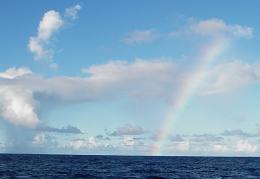 One of the nice things about the ITCZ (Intertropical Convergence Zone, an area of calms, squalls, variable winds and rain) is the number of rainbows you see. Sailing thru the ITCZ is more work than in most places, as you need to frequently set, reef and douse sails. We hope to be out of the ITCZ and into the Southeast Trade Winds in another day or two.
One of the nice things about the ITCZ (Intertropical Convergence Zone, an area of calms, squalls, variable winds and rain) is the number of rainbows you see. Sailing thru the ITCZ is more work than in most places, as you need to frequently set, reef and douse sails. We hope to be out of the ITCZ and into the Southeast Trade Winds in another day or two.
Sunrise
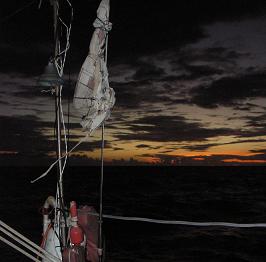 We are in the ITCZ (doldrums), and have had good conditions so far…only one real squall, and not many hours of flat calm. We expect to be in the ITCZ for a few more days, so expect to see several more squalls. All day today we have been pleasantly beating into light headwinds from the south, with sunny skies and small waves.
We are in the ITCZ (doldrums), and have had good conditions so far…only one real squall, and not many hours of flat calm. We expect to be in the ITCZ for a few more days, so expect to see several more squalls. All day today we have been pleasantly beating into light headwinds from the south, with sunny skies and small waves.
Fisherman
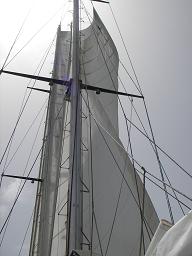 Went aloft yesterday to fix the AIS (more on this another time) antenna. Was very pleased that it was the easiest trip aloft I’ve ever done at sea (the steps on the mast are a great help). Yann, the previous owner, used to go aloft every time he set the fisherman (sail that sets up high, between the two masts, visible in the picture), as it had a roller furling system that jammed. The fisherman no longer has that roller furling system, so has not (yet) required any trips aloft. In the picture, we are going downwind with fisherman, main staysail (below the fisherman) and two headsails, which are obscured by the fisherman. The mainsail is down to keep the sail area forward, making it easier for the wind vane to steer the boat.We are getting closer to the ITCZ (Inter Tropical Convergence Zone), or Doldrums as they are also called. The sunny tradewind skies have been replaced more and more by squally, overcast conditions. We are doing a lot of sail changes, as the winds keep changing.
Went aloft yesterday to fix the AIS (more on this another time) antenna. Was very pleased that it was the easiest trip aloft I’ve ever done at sea (the steps on the mast are a great help). Yann, the previous owner, used to go aloft every time he set the fisherman (sail that sets up high, between the two masts, visible in the picture), as it had a roller furling system that jammed. The fisherman no longer has that roller furling system, so has not (yet) required any trips aloft. In the picture, we are going downwind with fisherman, main staysail (below the fisherman) and two headsails, which are obscured by the fisherman. The mainsail is down to keep the sail area forward, making it easier for the wind vane to steer the boat.We are getting closer to the ITCZ (Inter Tropical Convergence Zone), or Doldrums as they are also called. The sunny tradewind skies have been replaced more and more by squally, overcast conditions. We are doing a lot of sail changes, as the winds keep changing.
Saida
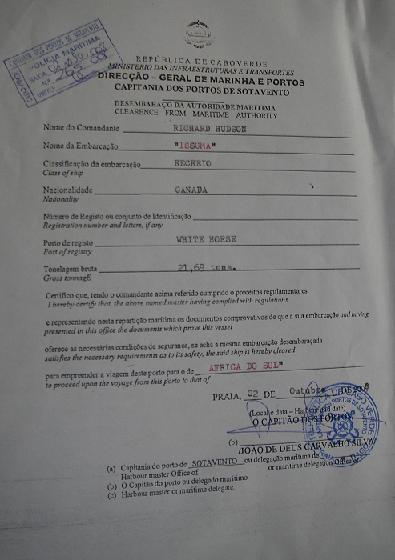 Exit (saida in Portuguese) papers from the Maritime Police that allow us to leave Cape Verde. The heat and humidity here in the tropics conspire to wilt any papers.While we are at sea, comments to the blog will appear on the blog, but I won’t be able to read them (I just have limited email access via satellite phone now) until we reach another port and find an internet cafe.
Exit (saida in Portuguese) papers from the Maritime Police that allow us to leave Cape Verde. The heat and humidity here in the tropics conspire to wilt any papers.While we are at sea, comments to the blog will appear on the blog, but I won’t be able to read them (I just have limited email access via satellite phone now) until we reach another port and find an internet cafe.
Rainbow Leaving Praia
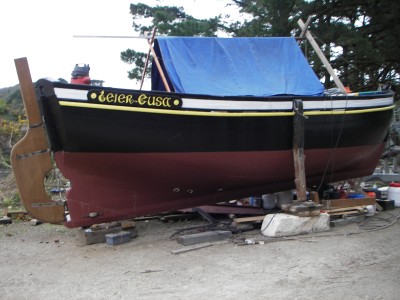 Not only rain to wash the African sand off the decks, but a rainbow as we left the Cape Verde islands. There is a lot of orange sand from the Sahara that sometimes blows onto everything in the Cape Verdes.
Not only rain to wash the African sand off the decks, but a rainbow as we left the Cape Verde islands. There is a lot of orange sand from the Sahara that sometimes blows onto everything in the Cape Verdes.
Praia Harbor
Abandoned fishing boats in Praia harbor. Issuma is just visible way off to the right.
Praia Market
Praia, Santiago, Cabo Verde
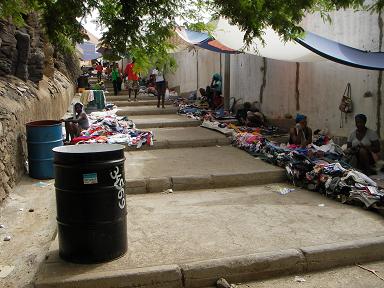 We arrived in Praia, on the island of Santiago, a couple of days ago. It is hot and interesting here.
We arrived in Praia, on the island of Santiago, a couple of days ago. It is hot and interesting here.